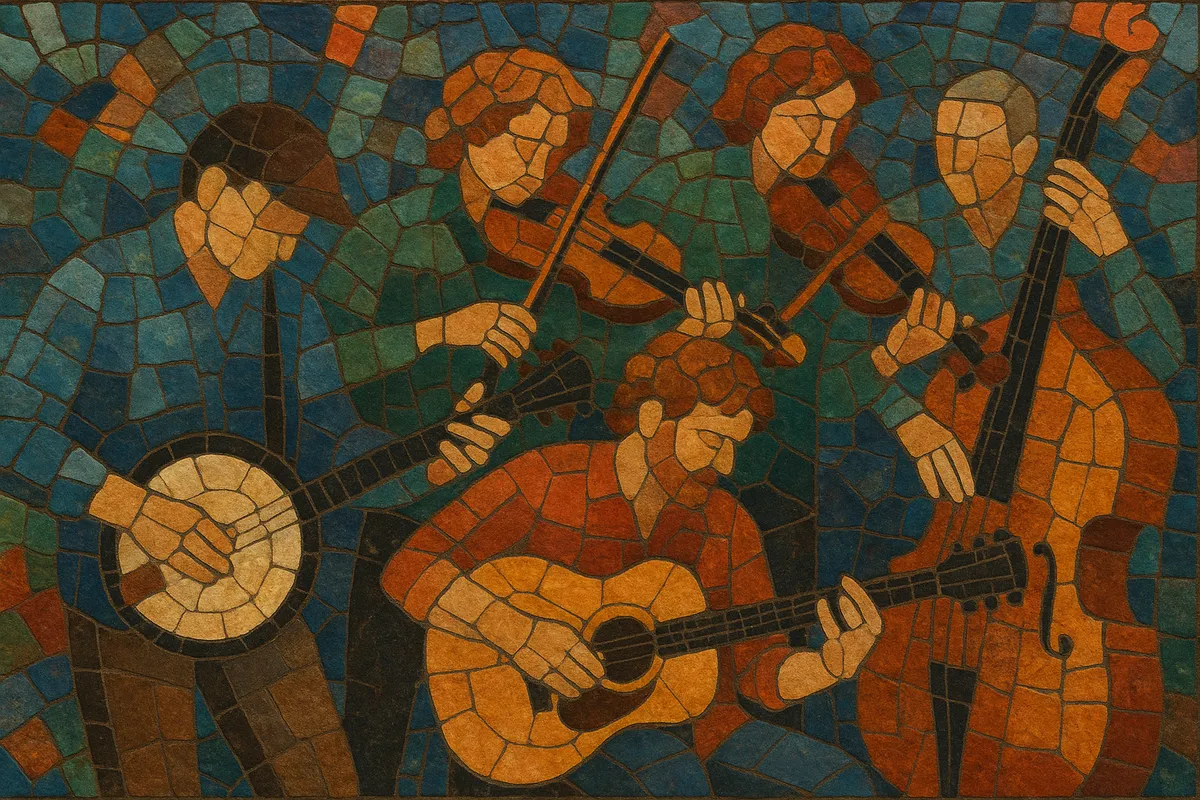Newgrass (often synonymous with progressive bluegrass) is a modern, exploratory branch of bluegrass that blends the acoustic virtuosity and ensemble interplay of traditional bluegrass with the harmony, rhythm, and songcraft of rock, folk, and jazz.
Typical newgrass ensembles keep the bluegrass core—mandolin, banjo, fiddle, acoustic guitar, and bass—while freely adding Dobro, percussion/drum set, piano, and occasional electric instruments. The style favors extended solos, odd meters, sophisticated harmonies, and reinterpretations of non-bluegrass repertoire alongside original songwriting.
The spirit of newgrass is adventurous and improvisational: players stretch traditional forms, use complex chord colors and modal harmony, and treat arrangements as living frameworks for creative interplay.
Newgrass coalesced in the United States at the turn of the 1970s as younger acoustic musicians, steeped in traditional bluegrass, embraced the energy of rock and the harmonic language of jazz. Landmark records and bands—John Hartford’s groundbreaking Aereo-Plain (1971), the formation of New Grass Revival (1971), and progressive outfits like The Seldom Scene and Country Gazette—signaled a shift toward drums, electric bass, contemporary songwriting, and improvisation. Festivals such as the Telluride Bluegrass Festival became hubs for the burgeoning movement.
David Grisman’s quintet fused bluegrass picking with jazz (“Dawg music”), while Tony Rice redefined flatpicking with sophisticated harmony and tone. Béla Fleck advanced melodic and chromatic banjo techniques, opening doors to complex arrangements and cross-genre collaborations. The term “newgrass” came to represent a mindset: reverence for tradition coupled with fearless innovation.
The 1990s saw wider audiences via Nickel Creek’s contemporary songwriting and Béla Fleck & the Flecktones’ jazz-fusion approach. Parallel to this, “jamgrass” acts (e.g., Yonder Mountain String Band, Leftover Salmon) adopted jam-band improvisation, expanding song lengths and rhythmic palettes while retaining acoustic drive.
Artists like Punch Brothers, Greensky Bluegrass, The Infamous Stringdusters, Molly Tuttle, and Billy Strings brought new levels of virtuosity, arranging sophistication, and popular appeal. Streaming-era visibility and cross-genre collaborations normalized pop and rock covers in a bluegrass context, while original material leaned into detailed arrangements, odd meters, and jazz-inflected harmony—all without losing the genre’s acoustic heart.
Start with mandolin, 5‑string banjo, fiddle, acoustic guitar, and upright (or electric) bass. Add Dobro, occasional drum kit or hand percussion, and keys when appropriate. Keep acoustic timbres central, even when expanding the palette.
Use bluegrass drive (mandolin chop on beats 2 and 4; walking or syncopated bass) but feel free to adopt rock backbeats, half-time feels, and odd meters (5/4, 7/8). Tempos commonly range from 80–160 BPM. Allow sections to stretch for solos and dynamic builds.
Go beyond I–IV–V. Employ modal flavors (Mixolydian and Dorian are common), secondary dominants, ii–V–I motion, and extended chords (add9, 11, 13). Re-harmonize traditional progressions; use voice-leading to connect chord tones smoothly under fast melodic lines.
Feature virtuosic flatpicking (guitar), crosspicking (guitar/mandolin), melodic/chromatic banjo lines, double-stop and shuffle bowing on fiddle, and rhythmic mandolin chops. Build arrangements around traded solos, call-and-response, and ensemble hits. Encourage jazz-like improvisation over agreed forms and vamps.
Blend originals with inventive covers of rock, pop, and folk tunes. Write contemporary lyrics (personal narratives, modern themes) while honoring bluegrass storytelling craft. Structure songs with intros/outros, instrumental breaks, and textural contrasts (duo sections, breakdowns, and full-band peaks).
Balance clarity and energy: mic acoustic instruments to preserve transient detail; leave headroom for dynamic solos. Use sectional contrast (meter or key shifts) to sustain interest. On stage, plan cue-based jams and modal vamps to facilitate spontaneous interaction.


